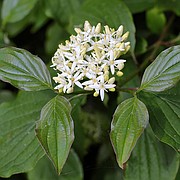Red osier dogwood brightens winter background
Winter is a time of repose in the plant world and showy displays are few and far between. Red osier dogwood (cornus sericea) is a notable exception. Growing in moist ground, this multi-stemmed shrub's ruby red stems stand out brightly against a snowy white or dun-colored winter background.
Native throughout North America, except the southern states from Texas to the Atlantic coast, Red osier dogwood is favored by landscapers and gardeners because it is hardy and versatile. It grows naturally in thickets up to 15 feet tall and lends itself well to hedges, while its fibrous root system helps stabilize soil on banks and slopes.
Spring brings bright green, oval leaves and flat-topped clusters of four to five-petaled frothy white flowers. Later in the summer off-white berries with a light blue cast appear. The foliage turns golden to red in the fall. Red osier dogwood is interesting in every season, and it provides cover and food for local birds.
Native Americans used Red osier dogwood to augment their tobacco stores. Scrapped threads of the inner bark of young stems were toasted over a fire then mixed with real tobacco. Older stems were also gathered to make baskets and roasting skewers. The name “dogwood” has no relation to our furry canine friends. It is a corruption of the Scandinavian word “dag” which means skewer. But that doesn't stop one from riddling, “How do you tell if it is a dogwood?” And the answer is: “By its bark, of course.”
One of the easiest places to see Red osier dogwood in the Sandpoint area is along the Sand Creek trail from City Beach north. As you leave downtown, the burgundy-colored stems of Red osier dogwood on both sides of the trail are hard to miss. You'll also find it in the Interior Rain Forest habitat at the North Idaho Native Plant Arboretum. Open to the public, parking for the Arboretum is at 611 S. Ella Ave. or on the street.
Red osier dogwood is found on page 83 of the KNPS publication, Landscaping with Native Plants in the Idaho Panhandle, available at local bookstores and the Bonner County History Museum. Native Plant Notes are created by the Kinnikinnick Native Plant Society. To learn more about KNPS and the North Idaho Native Plant Arboretum, visit www.nativeplantsociety.org.





